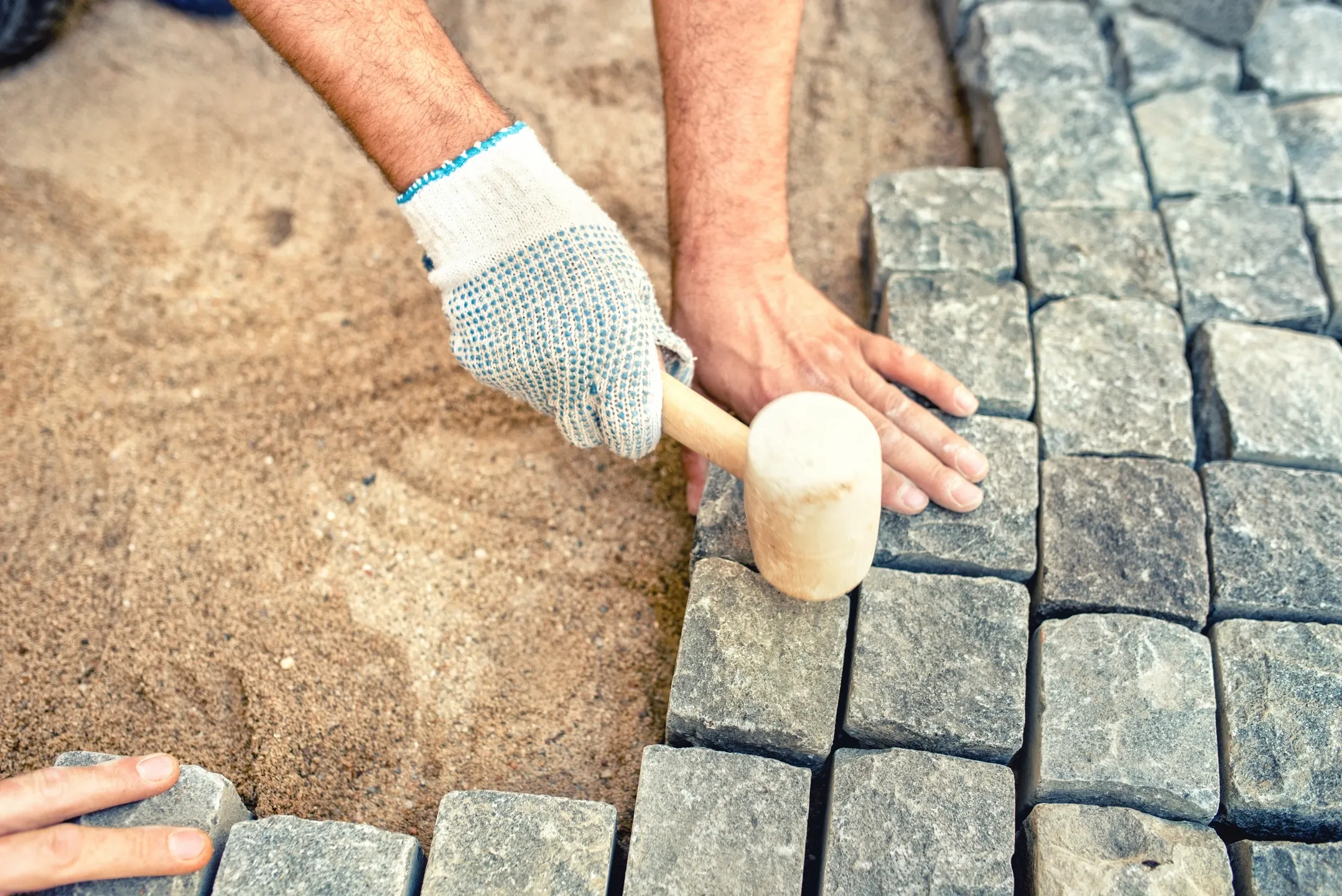As the sun casts its first golden rays upon the ancient city, it’s stone-clad walls and cobbled streets whisper tales of a time long past. The art of masonry, a tradition deeply rooted in history, has withstood the test of time, shaping the landscape of our world with enduring beauty and strength. When embarking on your own masonry masterpiece.
The choice of stone is paramount in weaving your narrative into the fabric of the ages. In this article, A-Z Landscaping delves into the labyrinth of lithic splendor, guiding you on a journey to discover the perfect stones for your masonry project. From the fiery birth of granite to the metamorphic allure of marble, let us embark on a voyage through the geological wonders that await your creative touch.
Types of Masonry Stones
Masonry stones, the building blocks of captivating structures and timeless artistry, are commonly classified into three distinct categories based on their geological formation: igneous, sedimentary, and metamorphic. Each category boasts its own unique characteristics, lending itself to specific applications and aesthetics that transform spaces with their distinct charm and allure.
Igneous stones, born from the fiery depths of the Earth, are formed as molten magma cools and solidifies. This arduous process yields an array of robust and durable stones, such as granite and basalt. These stones’ densely packed mineral composition contributes to their exceptional strength and resistance to wear, making them the quintessential choice for projects demanding resilience and longevity.
On the other hand, sedimentary stones tell a story of time and patience. These stones are formed through the gradual accumulation and compression of mineral, organic, and rock particles over vast expanses of time. The result is a diverse selection of stones, such as limestone and sandstone, characterized by their unique strata and earthy tones. Their versatile nature allows for many applications, from stately facades to tranquil garden walkways.
Metamorphic stones are the alchemists of the geological realm, transformed by intense heat and pressure within the Earth’s crust. Like marble and slate, these stones undergo a metamorphosis that imbues them with newfound elegance and strength. Often prized for their striking veining patterns and rich hues, metamorphic stones lend an air of sophistication to any space, be it a grand entrance or a serene sanctuary.
In essence, the geological tapestry that forms the foundation of our world offers many options for the discerning mason. Understanding the origins, characteristics, and applications of igneous, sedimentary, and metamorphic stones empowers you to make informed decisions that elevate your masonry project to new heights of beauty, durability, and timeless appeal.
Factors to Consider in Stone Selection
Embarking on the journey of selecting the perfect stone for your masonry project can be daunting. To ensure the ultimate harmony between form and function, it is essential to carefully weigh a multitude of factors. These vital elements include aesthetic appeal, durability, load-bearing capacity, environmental impact, and cost, each contributing to the success and longevity of your creation.
Aesthetic Appeal: The visual allure of your chosen stone sets the tone for your project, evoking emotions and creating a distinct ambiance. Consider the desired color, texture, and finish to ensure your stone selection complements the design vision. From sandstone’s earthy warmth to marble’s opulent sheen, selecting the right stone can transform a space into a visual masterpiece.
Durability: The test of time is a challenge that all masonry projects must face, and selecting a stone with the appropriate durability is crucial. Factors such as weather resistance, hardness, and the ability to withstand wear and tear should be considered. For instance, granite’s inherent strength makes it suitable for high-traffic areas and exterior applications, while softer stones like limestone may require additional protection.
Load-Bearing Capacity: Your masonry project’s structural integrity hinges on the chosen stone’s load-bearing capacity. Consider the weight and stress the stone will need to support, and select a material with adequate strength to ensure stability and safety. Some stones, such as granite, offer exceptional load-bearing capabilities, while others, like sandstone, may be more suitable for non-load-bearing applications.
Environmental Impact: In today’s world, the environmental footprint of our actions is of paramount importance. When selecting a stone for your masonry project, consider its extraction and transportation methods and the potential for recycling and repurposing. Opting for locally sourced and sustainable materials can minimize your project’s environmental impact while supporting local communities and businesses.
Cost: Budget constraints are a reality for many masonry projects, and the cost of your chosen stone can significantly influence the overall expenses. Balancing the desired aesthetic and functional qualities with cost considerations is essential for a successful project. Keep in mind that the initial cost of the stone should be weighed against its long-term maintenance and replacement expenses, as a higher upfront investment may yield savings in the future.
By carefully considering these factors, you can confidently select the ideal stone for your masonry project, creating a harmonious balance between beauty, function, and sustainability. With a thoughtful approach, your masterpiece will stand as a testament to your vision, skill, and dedication for future generations.
Popular Masonry Stones
Granite, a popular igneous stone, boasts impressive durability and strength, and its aesthetic appeal is characterized by a range of colors and patterns. This versatile stone is ideal for various applications, including countertops, flooring, and building exteriors.
Limestone, a sedimentary stone, is lauded for its soft, warm appearance. It is often utilized in landscaping, building facades, and interior finishes. However, its susceptibility to weathering necessitates proper sealing and maintenance.
Sandstone, another sedimentary rock, is celebrated for its unique texture and color variations. The stone’s inherent versatility makes it suitable for both interior and exterior applications, such as paving, cladding, and decorative features.
Slate, a metamorphic stone, is known for its natural cleavage and smooth finish. Its low porosity, with a striking visual impact, lends itself well to flooring and roofing applications.
Marble, an elegant metamorphic rock, is synonymous with luxury and opulence. This coveted material is often employed for flooring, countertops, and decorative elements, though it requires diligent maintenance to preserve its pristine appearance.
Masonry Techniques
Traditional and contemporary masonry techniques play a pivotal role in shaping the character and longevity of your project. Traditional masonry techniques, such as dry-stone construction and lime mortar, boast a rich history and a legacy of resilience. Dry-stone construction, for instance, relies on precisely placing stones without using mortar, creating structures that breathe and adapt to their environment. Lime mortar, a time-honored binder composed of lime, sand, and water, offers flexibility and breathability, ensuring the longevity of masonry structures in a variety of climates.
In contrast, modern advancements in masonry techniques have ushered in a new era of efficiency and durability. Innovative adhesives and reinforcement materials like epoxy resins and steel reinforcements allow for stronger bonds and increased structural stability. Additionally, advanced cutting and shaping tools have revolutionized how stones are crafted, enabling intricate designs and precise fitting that were once unimaginable.
By embracing a fusion of traditional craftsmanship and contemporary innovation, today’s masons can create structures that pay homage to the rich history of masonry and stand resilient in the face of future challenges.
Stone Treatment and Maintenance
The enduring beauty and integrity of masonry stones depend on implementing proper treatment and maintenance practices. Sealing and waterproofing treatments are indispensable to protect your stone from the ravages of time. These treatments form a protective barrier against moisture intrusion, staining, and the damaging effects of freeze-thaw cycles, prolonging your stone’s lifespan and preserving its visual allure.
Regular cleaning is another crucial aspect of stone maintenance. By using gentle, non-abrasive cleaning agents and methods, you can remove dirt, grime, and organic matter without compromising the integrity of the stone. Periodic cleaning enhances the aesthetic appeal of your masonry project and helps prevent mold, mildew, and algae growth, which can lead to structural deterioration.
In essence, investing time and effort in proper stone treatment and maintenance is essential for the longevity and beauty of your masonry project. By taking these proactive measures, you can ensure that your creation will continue to captivate and inspire generations to come.
Conclusion
In conclusion, selecting the ideal stone for your masonry project is a nuanced process that requires thoughtful consideration of various factors. By making informed choices, you can create a beautiful and enduring structure that stands the test of time. Educating yourself on the different types of stones, their unique characteristics, and appropriate applications will ensure that your project not only meets aesthetic expectations but also adheres to the highest durability and functionality standards.
As you embark on your masonry journey, be sure to explore the vast array of stones available on the market and consult with experts when necessary. Each stone possesses its inherent charm, and the thoughtful combination of these materials can create a truly captivating and harmonious design. By understanding the limitations and advantages of each stone type, you can make informed decisions that align with your project’s goals, budget, and environmental impact.
Furthermore, staying up-to-date with modern masonry techniques and best practices is crucial. Leveraging these advances in technology and methodology can lead to more efficient and resilient projects that seamlessly blend traditional craftsmanship with contemporary innovation. From the initial stone selection to the final treatment and maintenance, every step in the process plays a significant role in your masonry project’s overall success and longevity.
In conclusion, the world of masonry offers endless possibilities for creative expression and functional design. By choosing the right stones for your project and employing the appropriate techniques, you can create a lasting testament to the timeless art of masonry. Embrace the challenge and revel in the satisfaction of crafting a structure that not only captivates the senses but also stands steadfast as a testament to your vision, skill, and dedication.






